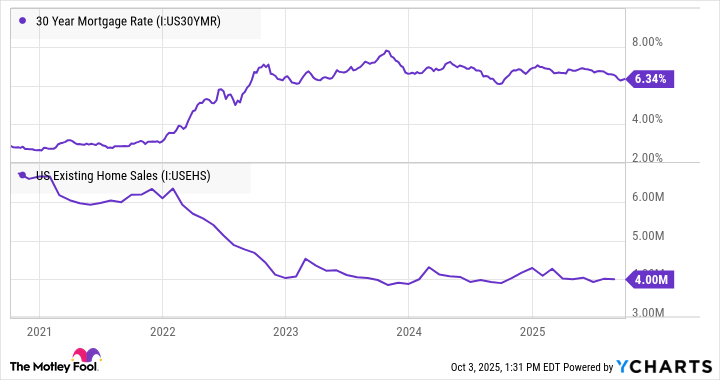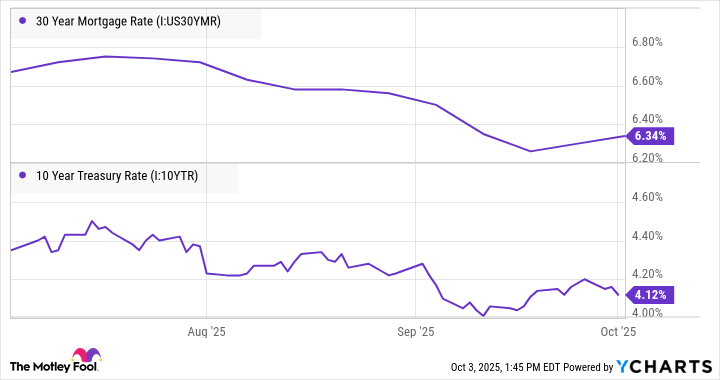Whirlpool (WHR +2.13%) shares declined by 15.6% in September, according to data provided by S&P Global Market Intelligence. The decline comes down to a combination of investors "selling on the news" of a rate cut and a relatively disappointing bond market reaction to the Federal Reserve rate cut in mid-September. Still, there's a bull case to be made for buying the stock in a dip. Here's the lowdown.
Whirlpool's difficult 2025
Two big external events are impacting Whirlpool this year. The first is the impact of interest rates on the housing market, specifically on home sales volumes. Homeowners typically undertake discretionary spending on major domestic appliances as they prepare their homes for sale or move into a recently purchased home.

NYSE: WHR
Key Data Points
As such, when mortgage rates rise and put pressure on home sales (see the chart below), Whirlpool's higher-margin discretionary sales will be weakened. Indeed, management noted in its second-quarter earnings presentation that U.S. demand for appliances from discretionary purchases contributed 30% of the total demand from 2015 to 2020. Still, that figure had dropped to just 20% by 2025.
Foreign competition and tariffs
The second event is the behavior of Asian competitors in response to the threat of tariffs earlier in the year and then after the tariffs on Asian countries were imposed, which were subsequently paused until Aug. 1. In both cases, Whirlpool's Asian competitors responded by preloading the market ahead of the full impact of tariffs.
Throw in the ongoing weakness in the housing market, and there's a perfect recipe for an intensely competitive pricing and promotional environment. That's precisely what happened to Whirlpool this year, and it's unlikely to ease until Asian competitors sell down the inventory they've loaded into the market -- something that would occur much more quickly in a lower interest rate environment.

Image source: Getty Images.
What happened in September
While it's impossible to know precisely why investors behave the way they do, my best guess would be that investors bought the stock on the rumor of a rate cut and then sold it on the news of it.
In addition, the reality is that market rates and mortgage rates are largely unchanged from their levels when the Federal Reserve cut its rate in mid-September.
30 Year Mortgage Rate data by YCharts.
What's next for Whirlpool
There won't be a quick fix to Whirlpool's pressures, and it's unlikely that all of its recent competitive underperformance is due to external factors. That said, the company now generates 62% of its sales from major domestic appliances in North America, and 80% of what it sells in the U.S. is made in the US.
In other words, it's well positioned to benefit from the Trump administration's tariff regime, and if it can navigate a difficult period, next year could be a significantly better environment for the company.

